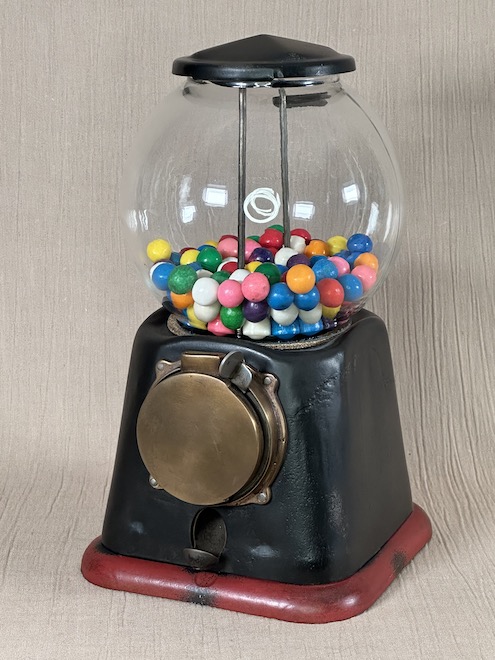___________________________________________________________________________________________
Royal Vendor

___________________________________________________________________________________________

Royal Gum Co., c. 1915, 12 1/4". This has a unique feature that sets it apart from most other 1-cent globe machines. If you look really really closely and squint off-axis to the left a bit, you may be able to discern that feature in the picture above. In most descriptions I explicitly point out things like that, but in this case I'm gonna let you ponder it and solve the mystery on your own.
Other than that one obscure feature, this is a fairly conventional sheet metal gum vendor. The surface texture in the picture above mimics that of cast iron, but nope---it's sheet metal. The globe on this model is like the one on the Advance Model D and similar Advance models but is a teensy bit smaller. A small round Advance globe I had lying around was too tall and too wide at the bottom to comfortably fit the machine above. It might have fit well enough had I removed the gaskets, but the globe that came on it fit perfectly so I left it. The reason I attempted the switch was that the Advance globe had a 1-cent decal not specific to a machine brand, and if the Royal globe was actually a small round Advance globe then it made sense to upgrade this one. I don't recall ever seeing a Royal Vendor with a decal, so I'm not sure the switch would have been 100% proper even had it fit.
I used to think Royal Vendors were fairly common but changed my mind over the years. Back in the early-to-mid-1990s I attended the Pasadena coin-op show twice a year and would usually see 2 or 3 of these at every show. I thought they were cool machines but they were priced above my comfort zone at the time, so I never bought one. In the mid-1990s I also started attending the Chicagoland show once or twice a year, and at some point I stopped seeing them at shows. I didn't notice that at the time---they just kinda sneakily faded from view---but one day I realized that it'd been years since I saw one. I mentioned this to a friend and he agreed with me---they dried up so gradually that neither of us had noticed.
Once I became re-aware of its existence, I decided to keep my eyes open and see if one came along that I liked. The qualifier "that I liked" eliminates most examples of this model from contention. Almost all of the Royal Vendors I'd seen over the years had a body that looked to have been painted recently and had a polished bicycle bell. I didn't want either of those features. I recall being told in the 1990s that a stash of these machines had been found and they'd all been restored, which if true would explain the consistent look of the examples I saw at shows.
The one shown above appeared in a Morphy auction in the Spring of 2024, with great patina on the mechanism and what appeared to be an old repaint. It was only the second one I'd ever seen with good patina on the mech and the body. The only reason I hadn't bought the first one years earlier was that the seller's price was....ummm...out of touch with the market value of the model at the time. If I were unkind I'd say it was insane, but I'm not so I won't.
Silent Salesmen Too has some interesting tidbits in its short description on page 135. First is that this model is nicknamed the "Bicycle Bell," which I knew, but it apparently is/was also called the "Thumb Press." I've never heard it called that but that doesn't mean it wasn't. Second is that the mechanism was chrome-plated brass. My strong memory of the ones I saw at shows is that they were polished brass, not chrome-plated. I do have a weak memory of some that were nickel-plated, though, including the one I'd have bought had the seller's price not been insane out of touch with market reality. And third is that the mechanism on this model "works similarly to the Advance gumball mechanism." I don't see that similarity from the front, so Bill must have been referring to the internal bits and design. It does make sense when you consider that this and the Advance Model D both rotate an axle clockwise through a partial turn to dispense a gumball---it's just hidden on the Royal and up-front on the Advance. Another Royal/Advance similarity is the hold-down ring and the lid, which are the same between brands except for the shape of the lid's top. On the Royal Vendor, the four quadrants each slope up to meet at a peak in the middle, whereas the Advance lids have a smooth shallow dome. And as mentioned above, the globes look exactly alike but differ slightly in size. So all in all, there are strong similarities between the Royal Vendor and some of the early Advance models. I don't know what, if any, the relationship was between Royal and Advance.
The example shown above is 100% original except the paint. I believe it's an old repaint, but can't point to anything specific like nicks and scratches and wear that indicate conclusively it has decades of age behind it. It sure looks the part, though.
___________________________________________________________________________________________
___________________________________________________________________________________________
©Small Vintage Vending 2024